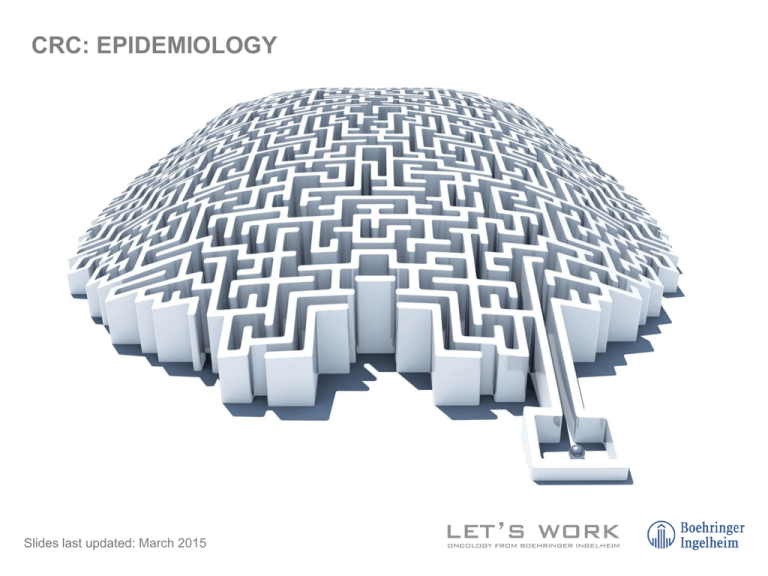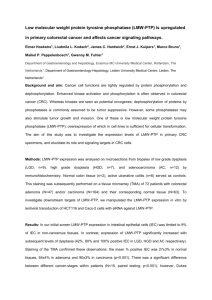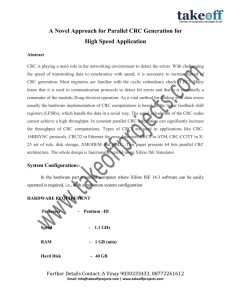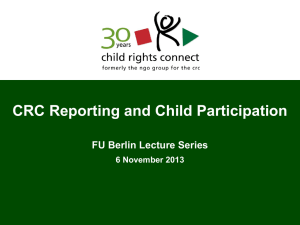All-in-one PPT
advertisement

CRC: EPIDEMIOLOGY Slides last updated: March 2015 Colorectal cancer incidence and mortality1 CRC caused 694,000 deaths in 2012, 8.5% of the total. Central and Eastern Europe had the highest mortality rates 30 Mortality (% of all cancer types) Colorectal cancer (CRC) is the third most common cancer in men and second most common in women worldwide, with 1.4 million new cases in 2012 Lung 25 Stomach 20 15 Liver 10 Colorectal 5 0 Both sexes Men Women Female breast 1. Ferlay J, Soerjomataram I, Ervik M, Dikshit R, Eser S, Mathers C, Rebelo M, Parkin DM, Forman D, Bray, F. GLOBOCAN 2012 v1.0, Cancer Incidence and Mortality Worldwide: IARC CancerBase No. 11 [Internet]. Lyon, France: International Agency for Research on Cancer; 2013. Available from: http://globocan.iarc.fr, accessed on 17/02/2015. Rates of CRC incidence and mortality differ worldwide1 Australia/New Zealand Western Europe 46% of new CRC cases and 52% of deaths by CRC occur in developing countries Southern Europe Northern Europe More developed regions Central and Eastern Europe Northern America Micronesia Eastern Asia Highest CRC rates are found in Australia/New Zealand CRC is the 2nd most common cancer in both men and women in this region World Caribbean South America Western Asia South-Eastern Asia Less developed regions Southern Africa Polynesia Melanesia Lowest CRC rates are found in Western Africa CRC is the 3rd most common cancer in men and 4th most common in women this region Central America Incidence Northern Africa Mortality Eastern Africa South-Central Asia Middle Africa Male Female Western Africa 50 40 30 20 10 0 10 20 30 40 50 Estimated age-standardized rates (World) per 100,000 1. Ferlay J, Shin HR, Bray F, Forman D, Mathers C and Parkin DM. GLOBOCAN 2008 v2.0, Cancer Incidence and Mortality Worldwide: IARC Cancer Base No.10 [Internet]. Lyon, France: International Agency for Research on Cancer; 2010. Available from: http://globocan.iarc.fr, accessed on 15/09/2013. Survival rates for CRC have been steadily improving1 Five-year survival trend 100 Colorectal cancer Percentage 80 60 40 Lung cancer 20 0 1975 1990 2005 Survival rates vary depending on stage at diagnosis. The later the stage of diagnosis the lower the survival rates tend to be. 1. SEER. Fast Stats Online. 5 year survival by diagnosis. 1975-2010. All races. All ages. Male and Female. Available online from seer.cancer.gov/faststats/selections.php, last accessed on 17/03/2015. Adenocarcinomas make up more than 95% of CRC1 CRC (100%) Adenocarcinomas start in gland cells that make mucus to lubricate the inside of the colon and rectum Less common types of CRC: •Carcinoid tumours •Gastrointestinal stromal tumours (GISTs) •Lymphomas •Sarcomas Adenocarcinoma (>95%) 1. American Cancer Society. Colorectal Cancer Detailed Guide, 2014. Available online from http://www.cancer.org/acs/groups/cid/documents/webcontent/003096-pdf.pdf, last accessed on 17/03/2015. CRC: CLASSIFICATION AND PATHOLOGY Slides last updated: March 2015 Adenocarcinomas make up more than 95% of CRC1 Adenocarcinomas start in gland cells that make mucus to lubricate the inside of the colon and rectum Less common types of CRC: •Carcinoid tumours •Gastrointestinal stromal tumours (GISTs) •Lymphomas •Sarcomas CRC (100%) Adenocarcinoma (>95%) 1. American Cancer Society. Colorectal Cancer Detailed Guide, 2014. Available online from http://www.cancer.org/acs/groups/cid/documents/webcontent/003096-pdf.pdf, last accessed on 17/03/2015. Less common types of CRC1 Carcinoid tumours start from specialised hormone-producing cells in the intestine Gastrointestinal stromal tumours (GISTs) start from specialised cells in the colon wall called the interstitial cells of Cajal. They can be found anywhere in the digestive tract, and are rare in the colon Lymphomas are cancers of the immume system that usually start in lymph nodes, but may also start in the colon, rectum and other organs Sarcomas start in blood vessels or in the muscle and connective tissue in the wall of the colon and rectum. Colorectal sarcomas are rare 1. American Cancer Society. Colorectal Cancer Detailed Guide, 2014. Available online from http://www.cancer.org/acs/groups/cid/documents/webcontent/003096-pdf.pdf, last accessed on 17/03/2015. Most CRCs develop slowly over several years1 Before a cancer develops, growth of tissue or tumour usually begins as a non-cancerous polyp on the inner lining of the colon or rectum Some polyps can become malignant (cancerous), but some remain benign (not cancerous) The two main types of polyps are: •Adenomas (adenomatous polyps) – develop into cancer •Hyperplastic polyps and inflammatory polyps – not pre-cancerous but might be considered as a sign of having a greater risk of developing adenomas Dysplasia is a pre-cancerous condition often seen in patients with inflammatory bowel disease. Cells in the lining of the colon or rectum may look abnormal under a microscope and develop into cancer over time 1. American Cancer Society. Colorectal Cancer Detailed Guide, 2014. Available online from http://www.cancer.org/acs/groups/cid/documents/webcontent/003096-pdf.pdf, last accessed on 17/03/2015. Loss of genomic stability can drive CRC1 Chromosomal instability: •Causes physical loss of a wild-type copy of tumour-suppressor genes such as APC, TP53 and SMAD4 •Unlike some other cancers, CRC does not commonly involved amplification of gene copy number or gene rearrangement DNA-repair defects: •Inactivation of genes required for repair of base-base mismatches in DNA, known as mismatch-repair genes •Can be inherited (HNPCC) or acquired •Leads to microsatellite instability (MSI) Aberrant DNA methylation: •Leads to gene inactivation •A methylated form of cytosine is observed in 15% of CRC cases 1. Markowitz SD, et al. N Eng J Med 2009;361:2449-60. Sequencing of CRC has shown its wide heterogeneity1 The average stage IV CRC genome has 15 mutated candidate cancer genes, and 61 mutated passenger genes (very low frequency mutational events) In the progression of CRC, genetic alterations target the following genes to either turn on oncogenic mediators or turn off tumour-suppressor factors: MSI (MMR mutation) (MLH1 methylation) Normal epithelium APC, -Catenin Chromosomal instability (eg, CDC4) Small adenoma KRAS, BRAF PIK3CA, PTEN Large adenoma TP53, BAX SMAD4, TGFBR2 Cancer Growth factors: •Oncogenic mediators that are turned on in CRC are COX-2 and EGFR •Tumour-suppressor factors that are turned off are 15-PGDH and TGF- 1. Markowitz SD, et al. N Eng J Med 2009;361:2449-60. Key pathways in CRC1 • APC mutations are present n 85% of CRCs • Result in the activation of the Wnt signalling pathway, regarded as the initiating event in CRC • TP53 mutations are present in 35-55% of CRCs • Lead to inactivation of the p53 pathway, which often coincides with the transition of large carcinomas into invasive carcinomas • KRAS and BRAF mutations are present in 37% and 13% of CRCs, respectively • The mitogen-activated protein kinase (MAPK) pathway is activated • BRAFV600E activating mutation is present in 8-12% of CRCs • PI3KCA activating mutations are present in one third of CRC cases • PTEN inactivating mutations lead to identical results (activation of PI3K) 1. Markowitz SD, et al. N Eng J Med 2009;361:2449-60. Key pathways in CRC1 • TGFBR2 is inactive in one third of CRCs, inactivating the TGF- pathway (mediator of growth arrest and apoptosis) • TGF- pathway inactivation coincides with the transition of an adenoma to high grade dysplasia or carcinoma • Approximately two-thirds of CRC cases show increased levels of COX2, an enzyme involved in the activation of prostaglandin signalling • This signalling pathways is a critical step in the development of an adenoma • The vascular endothelial growth factor (VEGF) and its receptor (VEGFR) stimulate angiogenesis • Angiogenic pathways appear to be involved in the growth and lethal potential of CRC 1. Markowitz SD, et al. N Eng J Med 2009;361:2449-60. CRC: RISK FACTORS Slides last updated: March 2015 Lifestyle-related risk factors in CRC1,2 • Diets that are high in red meats and processed meats -Conversely, diets that are high in vegetables, fruits and whole grains have been linked with a decreased risk of CRC • Physical inactivity • Obesity/high body mass index • Long-term smoking • Heavy use of alcohol 1. American Cancer Society. Colorectal Cancer Detailed Guide, 2014. Available online from http://www.cancer.org/acs/groups/cid/documents/webcontent/003096-pdf.pdf, last accessed on 17/03/2015. 2. National Comprehensive Cancer Network. NCCN Clinical Practice Guidelines on Colon Cancer. Version 2.2015. Available online from http://www.nccn.org/professionals/physician_gls/pdf/colon.pdf, last accessed on 17/03/2015. Personal and family history-related risk factors in CRC1,2 • Personal history of CRC or adenomas • Personal history of inflammatory bowel disease • Family history of CRC or adenomas - • The majority of CRC cases are sporadic; only 25% of CRC cases have a family history3 Screening for CRC before the age of 50 may be an option Inherited syndromes - 5-10% of CRC patients have inherited gene mutations - Includes familial adenomatous polyposis (FAP), hereditary nonpolyposis colon cancer (HNPCC, or Lynch syndrome), Turcot syndrome, Peutz-Jeghers syndrome and MUTYH-associated polyposis 1. American Cancer Society. Colorectal Cancer Detailed Guide, 2014. Available online from http://www.cancer.org/acs/groups/cid/documents/webcontent/003096-pdf.pdf, last accessed on 17/03/2015. 2. National Comprehensive Cancer Network. NCCN Clinical Practice Guidelines on Colon Cancer. Version 2.2015. Available online from http://www.nccn.org/professionals/physician_gls/pdf/colon.pdf, last accessed on 17/03/2015. 3. Migliore L, et al. J Biomed Biotechnol 2011;Article ID 792362. Other risk factors in CRC1,2 • Age - 90% of people diagnosed with CRC are ≥50 years old • Type 2 diabetes • Metabolic syndrome - • Combination of diabetes, high blood pressure and obesity Certain racial and ethnic backgrounds - African-Americans have the highest CRC rates in the US - Ashkenazi Jews (of Eastern European descent) have one of the highest CRC risks of any ethnic group in the world; several gene mutations associated with CRC risk have been found within this group 1. American Cancer Society. Colorectal Cancer Detailed Guide, 2014. Available online from http://www.cancer.org/acs/groups/cid/documents/webcontent/003096-pdf.pdf, last accessed on 17/03/2015. 2. National Comprehensive Cancer Network. NCCN Clinical Practice Guidelines on Colon Cancer. Version 2.2015. Available online from http://www.nccn.org/professionals/physician_gls/pdf/colon.pdf, last accessed on 17/03/2015. CRC: CLINICAL FEATURES Slides last updated: June 2015 CRC diagnosis includes several assessments1 • Complete medical history, as well as family history • Physical exam to look for masses in the abdomen and enlarged organs • Blood tests • Colonoscopy • Biopsy and lab tests of samples • Imaging tests 1. American Cancer Society. Colorectal Cancer Detailed Guide, 2014. Available online from http://www.cancer.org/acs/groups/cid/documents/webcontent/003096-pdf.pdf, last accessed on 17/03/2015. Colonoscopy and blood tests1 Colonoscopy: •Main procedure for diagnosis2 •Can determine the exact location, detect further lesions and remove polyps •If a complete colonoscopy is not possible, colonoscopy of the rectum and sigmoid colon should be combined with a barium enema2 Blood tests: •Complete blood count – to detect anaemia •Liver enzymes – to assess liver function •Tumour markers – most commonly in patients with a history of CRC 1. American Cancer Society. Colorectal Cancer Detailed Guide, 2014. Available online from http://www.cancer.org/acs/groups/cid/documents/webcontent/003096-pdf.pdf, last accessed on 17/03/2015. 2. Labianca R, et al. Ann Oncol 2013;24(Suppl 6):vi64-72. Tests of biopsy samples and imaging tests1 Tests of biopsy samples: •Gene tests – to detect specific mutations that impact treatment decisions, e.g., KRAS •MSI testing – detection of microsatellite instability may identify conditions such as HNPCC and affect treatment choice Imaging tests: •CT scans, ultrasounds, MRI scans and PET scans – to assess the presence and spread of cancer •Chest X-ray – to check if cancer has spread to the lungs •Angiography – to visualise blood supply to the cancer (particularly relevant if cancer has spread to the liver) 1. American Cancer Society. Colorectal Cancer Detailed Guide, 2014. Available online from http://www.cancer.org/acs/groups/cid/documents/webcontent/003096-pdf.pdf, last accessed on 17/03/2015. Some common CRC symptoms1,2 Most people with early CRC do not display symptoms of the disease. Symptoms are typically associated with relatively large tumours and/or advanced stages and tend not to be specific to the disease It is very important to discuss any potential CRC symptoms with a healthcare provider Change in bowel habits (persistent diarrhoea, constipation or narrowing of stool) Cramping and abdominal pain Blood in faeces (that may lead to darker faeces than normal) Rectal bleeding Unexplained weight loss Iron deficiency and anaemia Weakness and fatigue 1. American Cancer Society. Colorectal Cancer Detailed Guide, 2014. Available online from http://www.cancer.org/acs/groups/cid/documents/webcontent/003096-pdf.pdf, last accessed on 17/03/2015. 2. Labianca R, et al. Ann Oncol 2013;24(Suppl 6):vi64-72. Screening aims to find benign adenomas or early CRC1,2 Screening tests can be structural or faecal-based •Structural - Colonoscopy – most complete screening procedure - Flexible sigmoidoscopy – limited to the lower part of the bowel - Computed tomographic colonography (CTC) – virtual colonoscopy, under evaluation •Faecal-based - Faecal occult blood tests (FOBT) – test for blood in faeces; can be guaiac-based (gFOBT) or immunochemical (iFOBT or FIT) - Stool DNA test – test for known DNA alterations during CRC progression, under evaluation 1. National Comprehensive Cancer Network. NCCN Clinical Practice Guidelines on Colon Cancer Screening. Version 1.2014. Available online from http://www.nccn.org/professionals/physician_gls/pdf/colorectal_screening.pdf, last accessed on 17/03/2015. 2. Labianca R, et al. Ann Oncol 2013;24(Suppl 6):vi64-72. NCCN (US) screening recommendations1 A risk-based approach is recommended, with patients assigned to one of the following categories: •Average risk - ≥50 years of age - Negative family history - No history of adenoma, CRC or inflammatory bowel disease •Increased risk - Either a personal history of adenomas or sessile serrated polyps (SSPs), CRC or inflammatory bowel disease - Or a positive family history of CRC or advanced adenomas •High-risk syndromes - Either a family history of HNPCC - Or a personal or family history of polyposis syndromes 1. National Comprehensive Cancer Network. NCCN Clinical Practice Guidelines on Colon Cancer Screening. Version 1.2015. Available online from http://www.nccn.org/professionals/physician_gls/pdf/colorectal_screening.pdf, last accessed on 16/06/2015. 2. National Comprehensive Cancer Network. NCCN Clinical Practice Guidelines on Genetic/Familial High-Risk Assessment: Colorectal. Version 1.2015. Available online from http://www.nccn.org/professionals/physician_gls/pdf/genetics_colon.pdf, last accessed on 16/06/2015. NCCN (US) screening recommendations1 Guidance is provided for the following groups: • Average risk - • Recommended screening options include • colonoscopy every 10 years • annual faecal-based tests • flexible sigmoidoscopy every 5 years with or without an interval faecal-based test at year 3 Increased risk or high-risk syndromes - Surveillance programme tailored to the patient’s personal history and preferences as well as their detailed family history - Screening intervals (mostly colonoscopy) adjusted to match each case 1. National Comprehensive Cancer Network. NCCN Clinical Practice Guidelines on Colon Cancer Screening. Version 1.2015. Available online from http://www.nccn.org/professionals/physician_gls/pdf/colorectal_screening.pdf, last accessed on 16/06/2015. 2. National Comprehensive Cancer Network. NCCN Clinical Practice Guidelines on Genetic/Familial High-Risk Assessment: Colorectal. Version 1.2015. Available online from http://www.nccn.org/professionals/physician_gls/pdf/genetics_colon.pdf, last accessed on 16/06/2015. ESMO (European) screening recommendations1 Guidance for average-risk populations is provided: •Screening interval for gFOBT should not be >2 years - if iFOBT, the interval should be the same as for gFOBT or <3 years •Screening interval for flexible sigmoidoscopy and colonoscopy should not be <10 years and can be extended to 20 years New screening techniques such as CTC and stool DNA tests are still under evaluation and not recommended for screening in the average-risk population 1. Labianca R, et al. Ann Oncol 2013;24(Suppl 6):vi64-72. CRC: STAGING Slides last updated: March 2015 How colorectal cancer (CRC) is staged1 Stage describes the extent of cancer, and is one of the most important factors in determining prognosis and treatment options For CRC, stage is based on how far the cancer has grown into the intestinal wall, if it has reached nearby structures, and if it has spread to distant organs Staging is the process of determining how far the cancer has spread, and involves physical exam, biopsies, imaging tests and results of surgery Clinical staging uses results of the physical exam, biopsy and imaging tests. Pathologic staging combines these tests with results from surgery 1. American Cancer Society. Colorectal Cancer Detailed Guide, 2014. Available online from http://www.cancer.org/acs/groups/cid/documents/webcontent/003096-pdf.pdf, last accessed on 17/03/2015. TNM classification is the most commonly used system1 Growth Primary tumour (T) Spread Regional lymph nodes (N) Metastasis Distant metastasis (M) 1. American Cancer Society. Colorectal Cancer Detailed Guide, 2014. Available online from http://www.cancer.org/acs/groups/cid/documents/webcontent/003096-pdf.pdf, last accessed on 17/03/2015. The TNM staging system for CRC: T1 T categories describe the extent of spread through the layers that form the wall of the colon and rectum These layers, from inner to outer, include: •Mucosa – inner lining •Muscularis mucosa – a thin muscle layer •Submucosa – the fibrous tissue beneath this muscle layer •Muscularis propria – a thick muscle layer that contracts to force the contents of the intestines along •Subserosa and serosa – the thin outermost layers of connective tissue that cover most of the colon 1. American Cancer Society. Colorectal Cancer Detailed Guide, 2014. Available online from http://www.cancer.org/acs/groups/cid/documents/webcontent/003096-pdf.pdf, last accessed on 17/03/2015. The TNM staging system for CRC: T1 Tx: No description is possible due to incomplete information Tis: The cancer is at its earliest stage (in situ) and involves only the mucosa; it has not grown beyond the muscularis mucosa T1: The cancer has grown through the muscularis mucosa and extends into the submucosa T2: The cancer has grown through the submucosa and extends into the muscularis propria T3: The cancer has grown through the muscularis propria and into the outermost layers of the colon or rectum, but not through them T4a: The cancer has grown through the serosa, the outermost lining T4b: The cancer has grown through the wall of the colon or rectum and is attached to or has invaded nearby tissue or organs 1. American Cancer Society. Colorectal Cancer Detailed Guide, 2014. Available online from http://www.cancer.org/acs/groups/cid/documents/webcontent/003096-pdf.pdf, last accessed on 17/03/2015. The TNM staging system for CRC: N1 N categories indicate whether the cancer has spread to nearby lymph nodes, and if so, how many lymph nodes may be involved For an accurate estimation of lymph node involvement, ≥12 lymph nodes are removed during surgery and examined under a microscope Nx: No description is possible N0: No cancer cells in nearby lymph nodes N1: Cancer cells found in 1-3 nearby lymph nodes •N1a: 1 lymph node •N1b: 2-3 lymph nodes •N1c: Small deposits of cells found in areas of fat near lymph nodes, but not in the nodes themselves N2: Cancer cells found in ≥4 nearby lymph nodes •N2a: 4-6 lymph nodes •N2b: ≥7 lymph nodes 1. American Cancer Society. Colorectal Cancer Detailed Guide, 2014. Available online from http://www.cancer.org/acs/groups/cid/documents/webcontent/003096-pdf.pdf, last accessed on 17/03/2015. The TNM staging system for CRC: M1 M categories indicate whether the cancer has spread (metastasised) to distant organs such as the liver, lungs or distant lymph nodes M0: No distant spread is seen M1a: Cancer has spread to one distant organ or set of lymph nodes M1b: Cancer has spread to more than one distant organ or set of lymph nodes, or to distant parts of the peritoneum (lining of the abdominal cavity) Once the T, N and M categories have been determined – usually after surgery – the information is combined in a process called stage grouping Stages range from stage I (least advanced) to stage IV (most advanced) 1. American Cancer Society. Colorectal Cancer Detailed Guide, 2014. Available online from http://www.cancer.org/acs/groups/cid/documents/webcontent/003096-pdf.pdf, last accessed on 17/03/2015. Stages in CRC1 Cancer progression Stage 0 Stage I Stage IIA Stage IIIA Stage IVA Tis, N0, M0 T1-T2, N0, M0 T3, N0, M0 T1-T2, N1, M0 T1, N2a, M0 Any T, any N, M1a Stage IIIB Stage IVA T3-T4a, N0, M0 T2-T3, N2a, M0 T1-T2, N2b, M0 Any T, any N, M1b Stage IIB T4a, N0, M0 Stage IIC T4b, N0, M0 Stage IIIC T4b, N0, M0 T3-T4a, N2b, M0 T4b, N1-N2, M0 1. American Cancer Society. Colorectal Cancer Detailed Guide, 2014. Available online from http://www.cancer.org/acs/groups/cid/documents/webcontent/003096-pdf.pdf, last accessed on 17/03/2015. Survival rates for CRC by stage1 Five-year relative survival rate 100 Colon cancer Survival rate (% ) 80 Rectal cancer Refers to the percentage of patients who live at least 5 years after diagnosis 60 40 20 0 I IIA IIB IIIA IIIB IIIC IV Relative survival rates compare observed survival with what would be expected without cancer Stage 1. American Cancer Society. Colorectal Cancer Detailed Guide, 2014. Available online from http://www.cancer.org/acs/groups/cid/documents/webcontent/003096-pdf.pdf, last accessed on 17/03/2015. Grades of CRC1 Survival is also affected by the grade of cancer Grade describes how closely the cancer looks like normal tissue when viewed under a microscope •Grade 1 (G1): cancer looks much like normal colorectal tissue •Grade 4 (G4): cancer looks very abnormal •Grades 2 and 3 (G2 and G3) fall in between G1 and G4 Often simplified to either low grade (G1, G2) or high grade (G3, G4) Low-grade cancers tend to grow and spread more slowly than highgrade cancers The outlook for low-grade cancers tends to be better than for high-grade cancers 1. American Cancer Society. Colorectal Cancer Detailed Guide, 2014. Available online from http://www.cancer.org/acs/groups/cid/documents/webcontent/003096-pdf.pdf, last accessed on 17/03/2015. CRC: ANATOMY OF THE GASTROINTESTINAL TRACT Slides last updated: March 2015 The wall of the GI tract is composed of four layers1 GI tract wall 1. Mucosa 2. Submucosa Lumen 3. Muscularis 4. Serosa 1. Tortora GJ, et al. Principles of Anatomy and Physiology. 11th Ed. Hoboken: John Wiley & Sons;2006:895-946. The wall of the GI tract is composed of four layers1 1. Mucosa • Mucous membrane that lines the lumen of the GI tract •Further divided into the epithelium, lamina propria and muscularis mucosa 2. Submucosa •Areolar connective tissue that binds the mucosa to the muscularis •Contains blood and lymphatic vessels that receive the absorbed nutrients •Also contains glands, lymphatic tissue and an extensive network of neurons 1. Tortora GJ, et al. Principles of Anatomy and Physiology. 11th Ed. Hoboken: John Wiley & Sons;2006:895-946. The wall of the GI tract is composed of four layers1 3. Muscularis •Contains either skeletal muscle for voluntary control of movement, or smooth muscle organised in two sheets of perpendicular fibres to generate involuntary contractions 4. Serosa •Superficial layer of the GI tracts segments that are suspended in the abdominopelvic cavity •Also called the visceral peritoneum •Composed of areolar connective tissue and simple squamous epithelium 1. Tortora GJ, et al. Principles of Anatomy and Physiology. 11th Ed. Hoboken: John Wiley & Sons;2006:895-946. Stage is determined by how far the cancer has spread1 Cancer progression Stage 0 Cancer is in the mucosa only Stage IA-B Stage IIA-C Stage IIIA-C Stage IVA-B Cancer has grown through the muscularis mucosa or submucosa Cancer has grown through the muscularis propria, serosa, or through the colon or rectum wall Cancer has grown through at least the muscularis mucosa, and has been found in nearby lymph nodes Cancer has grown through at least the muscularis mucosa and has spread to distant organs (metastasised) 1. American Cancer Society. Colorectal Cancer Detailed Guide, 2014. Available online from http://www.cancer.org/acs/groups/cid/documents/webcontent/003096-pdf.pdf, last accessed on 17/03/2015.





